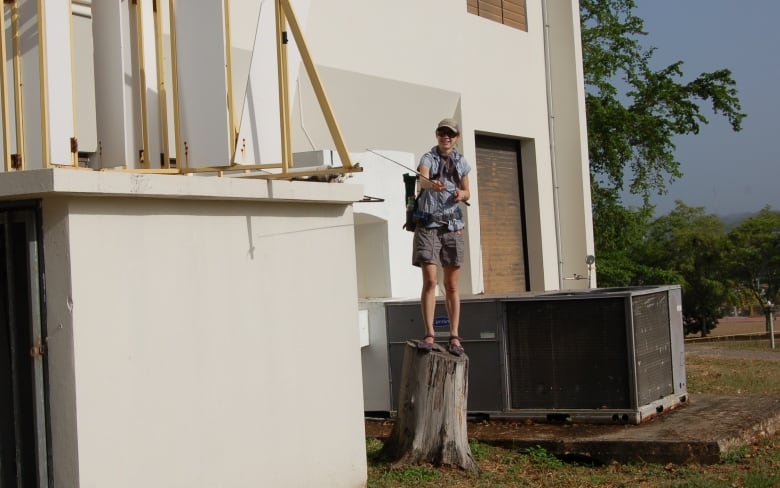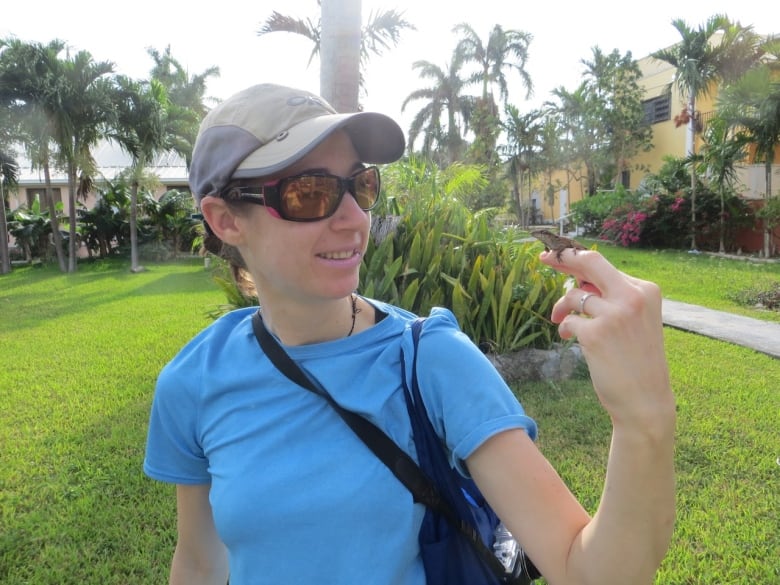
As It Happens6:47City lizards are just built different — right down to their DNA
If you’ve recently been to a Puerto Rican city, you may have noticed a woman wandering the streets with a fishing pole, looking for lizards.
That would be New York University biologist Kristin Winchell, a.k.a. “the Lizard Lady.”
Winchell has just published a study showing that city lizards are genetically different from their counterparts in the forest.
But before she could study the critters’ DNA, she and her colleagues first had to catch them — a feat they accomplished using a fishing pole with a tiny lasso fastened to the end.
“That’s the best part of this job. We just walk around the forests or in the urban areas … and whenever we see a lizard, we take out our fishing pole,” Winchell told As It Happens host Nil Köksal.
“A lot of people seem to think we’re looking for Pokemon, actually. I don’t know why a fishing pole would play into that, but that’s a common question we get.”

But Winchell and her team found something rarer than the rarest of Pokemon — hard evidence that perfectly backed up their scientific hypothesis.
She and her colleagues had already shown Anolis lizards living in cities are physically different from those that dwell in nature.
Despite being mostly indiscernible at a glance, city lizards, in fact, have bigger toe pads and specialized scales that help them cling to urban surfaces like glass and pavement, and longer limbs that help them sprint more quickly across hot pavement.
But the new findings — published Thursday in the journal Proceedings of the National Academy of Sciences — shows those differences are far more than skin deep.
Jaw-dropping findings
The study analyzed 96 Anolis cristatellus lizards, comparing the genetic makeup of forest-dwellers to those living in Puerto Rico’s capital, San Juan, as well as the northern city of Arecibo and western city of Mayaguez.
They found that 33 genes within the lizard genome were common across all three otherwise genetically distinct urban populations.
The fact that the exact same genetic changes happened across three populations independent of each other means they are likely the direct result of urbanization.
“Practically speaking, that means [for] that any of these populations of lizards across the island, if a city were to spring up, that ancestral population of forest lizards has the genetic machinery to produce the same type of adaptations,” Winchell said.
“So if they were to bulldoze a forest and build up a city, the lizards would probably have the same long limbs and large toe pads with lots of extra scales.”
The lizards live roughly seven years, and the genetic changes can occur within 30 to 80 generations.

She and her team had suspected the city lizards were genetically adapting to their environment, but the evidence, she said, was almost too perfect.
“Honestly, when we got some of these findings, my jaw dropped,” Winchell said.
“I didn’t believe it at first, but I ran analysis after analysis, and my co-authors had to stop me at a certain point and said, ‘Kristin, you’ve shown the same thing using five different analyses. It’s real. Let’s go ahead and publish this now.'”
Wouter Halfwerk, an evolutionary ecologist and professor at Vrije University Amsterdam who was not involved in the study, said he was impressed that the scientists were able to detect such a clear genomic signature of adaptation.
“You can hardly get closer to a smoking gun,” he told The Associated Press. “The ultimate goal within the field of urban adaptive evolution is to find evidence for heritable traits and their genomic architecture.”
Lizard Lady longs to look for lady lizards
One limitation of the study, Winchell said, is that it only looked at male lizards.
It wasn’t Winchell’s preference, but she says almost all the previously existing literature about the species focused on the males. It’s a common problem in biology writ large, she says, and it’s a cycle that tends to perpetuate itself.
“In order to both build hypotheses that are founded in the previous literature and to be able to compare with that previous literature, we decided to focus on the same subset of animals,” she said. “So it’s an unfortunate legacy of how a lot of biology has been done.”
It’s a cycle she hopes to break in future studies.
“That’s definitely an area that I want to explore: to try and understand how the ecology of the female urban lizards differs from the male urban lizards, and what the consequences are for the evolution of these animals in cities,” she said.

So she may yet be out again on the streets of Puerto Rico with her fishing pole.
“I have a couple of nicknames,” she said. “One is Lizard Lady and the other is Total el Dia” — which means “all day” in Spanish” — “because I’m often in these neighbourhoods and areas all day long looking for lizards.”














